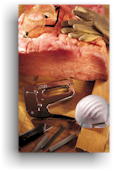Benefits of Air Sealing
Priorities for Air Sealing
Air Sealing Materials
Ventilation is fresh air that enters a house in a controlled manner to exhaust excess
moisture and reduce odors and stuffiness. Air leakage, or infiltration, is outside air
that enters a house uncontrollably through cracks and openings. It is unwise to rely on
air leakage for ventilation. During cold or windy weather, too much air may enter the
house and, during warm or calm weather, too little. Also, a leaky house that allows moldy,
dusty crawlspace or attic air to enter is not healthy. The recommended strategy in both
new and old homes is to reduce air leakage as much as possible and to provide controlled
ventilation as needed. For simple house designs, effective spot ventilation, such as
kitchen and bath fans that exhaust to the outside, may be adequate. For more complex
houses or ones in colder climates, whole house ventilation systems may be appropriate.
Such systems may incorporate heat recovery, moisture control, or air filtering.
 |
Benefits of Air Sealing
Air infiltration can account for 30 percent or more of a home’s heating and cooling
costs and contribute to problems with moisture, noise, dust, and the entry of pollutants,
insects, and rodents. Reducing infiltration can significantly cut annual heating and
cooling costs, improve building durability, and create a healthier indoor environment. The
size of heating and cooling equipment can also be decreased, which saves additional
dollars. Reducing air leakage in new homes, as required by the 1995 Model Energy Code,
typically costs less than $200 for the average home and does not require specialized
labor. |
Priorities for Air Sealing
Although windows, doors, and outside walls contribute to air leakage, the biggest holes
are usually hidden from view and connect the house to the attic, crawlspace, or basement.
The key is to identify these areas during the design process, assign responsibility for
sealing holes, and check to ensure that the air sealing was done effectively. Usually,
seal all the big holes first, then the large cracks and penetrations, and finally the
smaller cracks and seams.
Air Sealing Materials
Use a combination of these different air sealing materials.
- Caulk - Seals gaps of less than ½ inch. Select grade (interior, exterior, high
temperature) based on application.
- Spray foam - Fills large cracks and small holes. It can be messy; consider new
latex-based foams. DO NOT USE near flammable applications (e.g., flue vents). DO NOT USE
expanding types on windows and doors.
- Backer rod - Closed-cell foam or rope caulk. Press into crack or gap with screwdriver or
putty knife. Often used with caulk around window and door rough openings.
- Gaskets - Apply under the bottom plate before an exterior wall is raised or use to seal
drywall to framing instead of caulk or adhesive.
- Housewrap - Installed over exterior sheathing. Must be sealed with housewrap tape or
caulk to form an airtight seal. Resists water but is not a vapor barrier.
- Sheet goods (plywood, drywall, rigid foam insulation) - These materials form the air
barrier. Air leaks only at unsealed seams or penetrations.
- Sheet metal - Used with high-temperature caulk for sealing high-temperature components,
such as flues and chimneys, to framing.
- Polyethylene plastic - This inexpensive material for air sealing also stops vapor
diffusion. All edges and penetrations must be completely sealed for an effective air
barrier. Poly is fragile, and proper placement is climate specific.
- Weatherstripping - Used to seal moveable components, such as doors, windows, and attic
accesses.
- Mastic - Seals air handlers and all duct connections and joints.
- UL181 or foil-faced tape - Temporarily seals the air handler.
|

